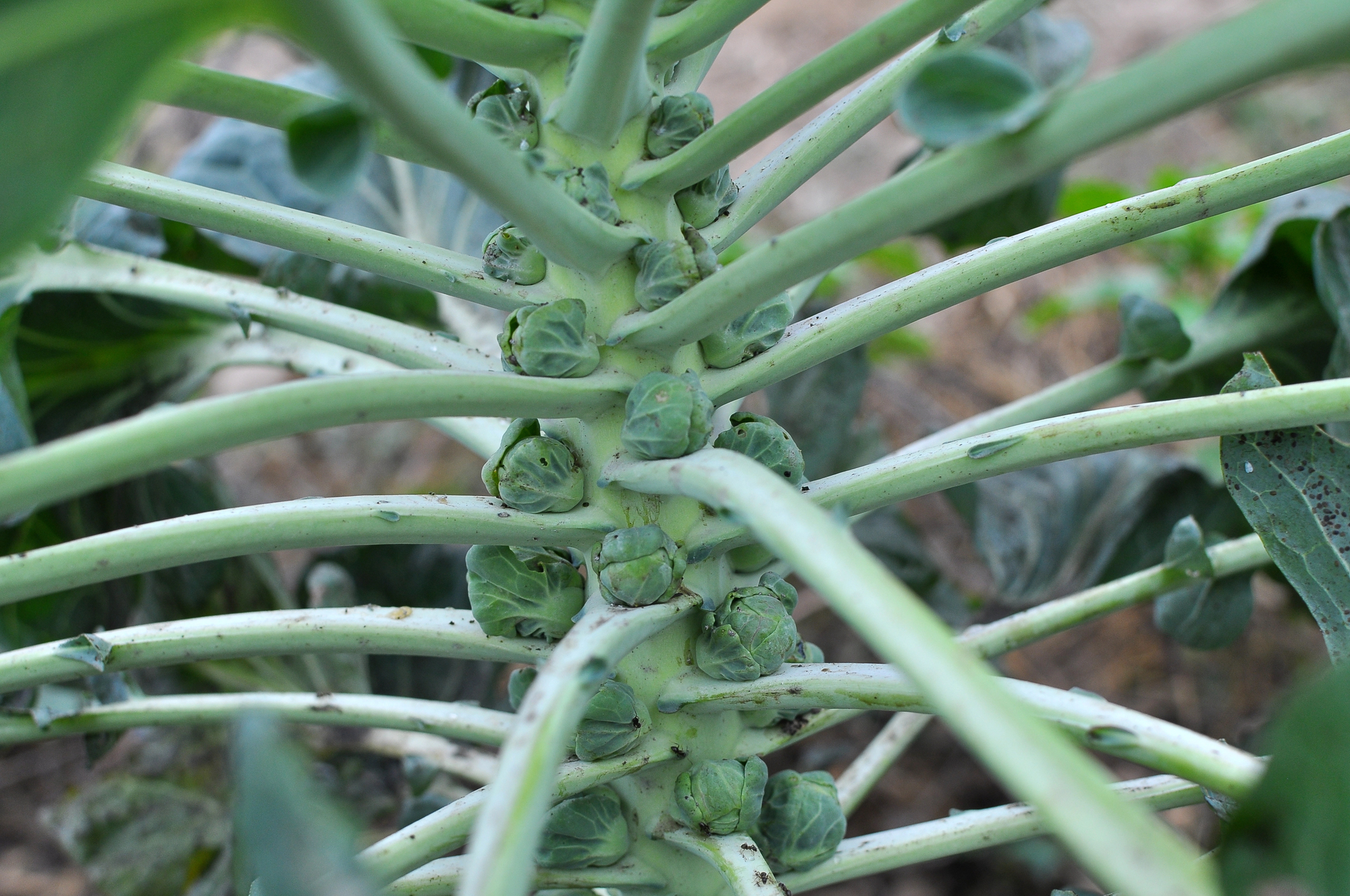Brussels Sprout Donation Tracker
Quick Links: How & Where to Grow | Temperature | How to Care For | Harvest Signs | Harvesting | Pruning | Pests | Companions | Varieties | Preservation | Recipes | Michigan Tips | Fun Facts
🌱 How & Where to Grow Brussels Sprouts
- Start indoors 12-14 weeks before first fall frost (mid-June in Michigan).
- Transplant to garden 6-8 weeks before first frost.
- Space plants 18-24 inches apart in rows 30 inches apart.
- Direct seed option: Plant in garden by late May for fall harvest.
- Sunlight: Full sun (6-8 hours) but tolerates partial shade.
- Soil Type: Rich, well-drained soil with pH 6.0-6.8.
- Soil Amendment: Heavy feeder – add generous compost and aged manure.
Brussels sprouts are the ultimate fall crop – frost makes them incredibly sweet!
🌡️ Temperature Guidance:
Thrives 60-65°F. Sweetens after frost. Tolerates 20°F when mature.
- Optimal growth: 60-70°F days, 50-60°F nights.
- Heat sensitivity: Poor sprout development above 75°F.
- Frost benefit: Light frosts convert starches to sugars.
- Cold tolerance: Mature plants survive down to 20°F.
- Requires 80-100 days from transplant to harvest.
Michigan’s cool falls are perfect – brussels sprouts actually improve with cold weather!
💧 How to Care for:
- Consistent Moisture: Essential for steady growth and sprout development.
- Watering: 1-1.5 inches weekly – consistent moisture prevents loose sprouts.
- Mulch: 3-4 inches to retain moisture and regulate soil temperature.
- Fertilizer: Side-dress monthly with balanced fertilizer or compost.
- Support: Stake tall varieties in windy locations to prevent toppling.
📏 Harvest Signs:
Sprouts 1-2 inches diameter. Firm and bright green. Bottom sprouts mature first.
- Size: Harvest when sprouts reach 1-2 inches diameter.
- Firmness: Should feel solid and tightly formed.
- Color: Bright green indicates peak quality.
- Progression: Harvest from bottom up as sprouts mature.
- Best flavor after several light frosts!
Brussels sprouts can be harvested all winter in Michigan with protection – they’re incredibly cold hardy!
🧺 Harvesting:
Twist off individual sprouts. Or cut entire stalk. Can harvest through winter.
- Individual harvest: Twist sprouts off stalk when firm.
- Remove leaves below harvested sprouts for easier access.
- Whole stalk: Cut entire stalk before ground freezes solid.
- Storage on stalk: Hang whole stalks in cool basement.
- Extended harvest: Leave in garden with mulch protection.
✂️ Pruning:
Top plants in early September. Remove lower leaves as you harvest.
- Topping: Pinch growing tip 4-6 weeks before first hard frost.
- Purpose: Forces energy into developing existing sprouts.
- Leaf removal: Strip yellowing lower leaves to improve air circulation.
- Clean stem: Remove leaves below developing sprouts.
- Don’t top too early: Wait until lower sprouts are forming.
🪲 Michigan Pests:
Aphids (worst pest), cabbage worms, flea beetles.
- Aphids: Gray cabbage aphids love cool weather – blast off with water.
- Cabbage worms: Green caterpillars – use Bt spray or row covers.
- Flea beetles: Early season damage – protect young plants.
- Club root: Soil disease – rotate crops, improve drainage.
- Fewer pests in fall than spring crops!
🫱🏽🫲🏼 Companions:
Good with onions, beets, carrots, herbs. Avoid strawberries, tomatoes.
- Onions and garlic: Deter many brassica pests.
- Beets and carrots: Use space while sprouts develop.
- Aromatic herbs: Thyme, sage, and hyssop repel pests.
- Avoid tomatoes: Heavy feeders compete for nutrients.
- Keep away from: Pole beans and strawberries.
🥬 Varieties:
‘Jade Cross’, ‘Long Island Improved’, ‘Diablo’, ‘Falstaff’.
- ‘Jade Cross’: 85 days, disease resistant, uniform sprouts.
- ‘Long Island Improved’: 90 days, heirloom, very cold hardy.
- ‘Diablo’: 110 days, tall plants, excellent for freezing.
- ‘Falstaff’: 105 days, purple sprouts, nutty flavor.
- ‘Dagan’: 100 days, early maturing, good for short seasons.
🫙 Preservation:
Freeze blanched 3-5 minutes. Store on stalk. Fresh 3-4 weeks.
- Fresh storage: Keep on stalk in cold storage up to 2 months.
- Refrigerator: Loose sprouts keep 3-4 weeks in perforated bag.
- Freezing: Blanch small sprouts 3 minutes, large 5 minutes.
- Root cellar: Whole stalks store at 32-40°F for months.
- Pickling: Makes excellent pickled vegetables.
🧑🏽🍳 Recipes:
Roasted brussels sprouts, shaved brussels salad, maple glazed, brussels gratin.
- Roasted with bacon and balsamic glaze.
- Shaved raw brussels sprout salad with lemon.
- Maple-dijon glazed brussels sprouts.
- Brussels sprout gratin with gruyere.
- Pan-fried with garlic and parmesan.
✋🏼 Michigan Tips:
- Time planting for harvest after first frost – transforms flavor!
- Can harvest all winter with row cover protection.
- Michigan’s long, cool falls ideal for extended harvest.
- Plant by July 4th for Thanksgiving harvest.
- Leave in garden until needed – cold storage in the ground!
- Growing season often extends into December.
🧠 Fun Facts:
- Named after Brussels, Belgium where they were popularized in the 16th century.
- One stalk can produce 20-40 sprouts weighing 3 pounds total.
- Contain more vitamin C than oranges!
- Thomas Jefferson grew them at Monticello in 1812.
- The UK eats more brussels sprouts per capita than any other country.
- Smallest cabbage family member but highest in protein.
- Ancient Romans ate a predecessor vegetable to treat hangovers.
- Modern varieties are much sweeter than the bitter ones from decades ago!


0 Comments